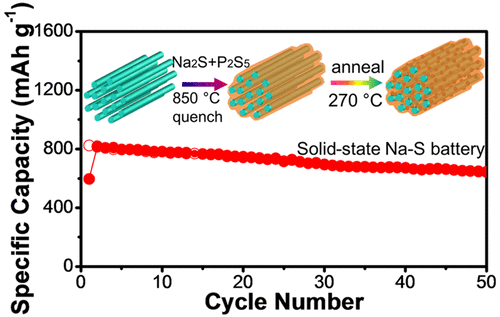Our official English website, www.x-mol.net, welcomes your
feedback! (Note: you will need to create a separate account there.)
High-Performance All-Solid-State Na–S Battery Enabled by Casting–Annealing Technology
ACS Nano ( IF 15.8 ) Pub Date : 2018-03-16 00:00:00 , DOI: 10.1021/acsnano.7b08856 Xiulin Fan , Jie Yue , Fudong Han , Ji Chen , Tao Deng , Xiuquan Zhou , Singyuk Hou , Chunsheng Wang
ACS Nano ( IF 15.8 ) Pub Date : 2018-03-16 00:00:00 , DOI: 10.1021/acsnano.7b08856 Xiulin Fan , Jie Yue , Fudong Han , Ji Chen , Tao Deng , Xiuquan Zhou , Singyuk Hou , Chunsheng Wang

|
Room-temperature all-solid-state Na–S batteries (ASNSBs) using sulfide solid electrolytes are a promising next-generation battery technology due to the high energy, enhanced safety, and earth abundant resources of both sodium and sulfur. Currently, the sulfide electrolyte ASNSBs are fabricated by a simple cold-pressing process leaving with high residential stress. Even worse, the large volume change of S/Na2S during charge/discharge cycles induces additional stress, seriously weakening the less-contacted interfaces among the solid electrolyte, active materials, and the electron conductive agent that are formed in the cold-pressing process. The high and continuous increase of the interface resistance hindered its practical application. Herein, we significantly reduce the interface resistance and eliminate the residential stress in Na2S cathodes by fabricating Na2S-Na3PS4-CMK-3 nanocomposites using melting-casting followed by stress-release annealing-precipitation process. The casting–annealing process guarantees the close contact between the Na3PS4 solid electrolyte and the CMK-3 mesoporous carbon in mixed ionic/electronic conductive matrix, while the in situ precipitated Na2S active species from the solid electrolyte during the annealing process guarantees the interfacial contact among these three subcomponents without residential stress, which greatly reduces the interfacial resistance and enhances the electrochemical performance. The in situ synthesized Na2S-Na3PS4-CMK-3 composite cathode delivers a stable and highly reversible capacity of 810 mAh/g at 50 mA/g for 50 cycles at 60 °C. The present casting–annealing strategy should provide opportunities for the advancement of mechanically robust and high-performance next-generation ASNSBs.
中文翻译:

铸造退火技术实现高性能全固态Na-S电池
使用硫化物固体电解质的室温全固态Na–S电池(ASNSB)由于具有高能量,增强的安全性以及钠和硫的地球丰富资源,是一种有前途的下一代电池技术。当前,硫化物电解质ASNSB是通过简单的冷压工艺制造的,留下了较高的居住应力。更糟糕的是,S / Na 2的体积变化很大充放电循环中的S会引起额外的应力,从而严重削弱在冷压过程中形成的固体电解质,活性材料和电子导电剂之间接触较少的界面。界面电阻的高且连续增加阻碍了其实际应用。在本文中,我们通过熔铸法和应力释放退火-沉淀法制备了Na 2 S-Na 3 PS 4 -CMK-3纳米复合材料,从而显着降低了界面电阻并消除了Na 2 S阴极中的驻留应力。铸造退火工艺可确保Na 3 PS 4之间的紧密接触固体电解质和CMK-3介孔碳在离子/电子混合导电基质中的混合,而在退火过程中从固体电解质中原位沉淀的Na 2 S活性物种保证了这三个子组分之间的界面接触而没有驻留应力,这大大降低了界面电阻,增强电化学性能。在原位合成的Na 2 S-的Na 3 PS 4-CMK-3复合阴极在60°C下可在50 mA / g下提供810 mAh / g的稳定且高度可逆的容量,可进行50次循环。当前的铸造-退火策略应该为机械坚固,高性能的下一代ASNSB的发展提供机会。
更新日期:2018-03-16
中文翻译:

铸造退火技术实现高性能全固态Na-S电池
使用硫化物固体电解质的室温全固态Na–S电池(ASNSB)由于具有高能量,增强的安全性以及钠和硫的地球丰富资源,是一种有前途的下一代电池技术。当前,硫化物电解质ASNSB是通过简单的冷压工艺制造的,留下了较高的居住应力。更糟糕的是,S / Na 2的体积变化很大充放电循环中的S会引起额外的应力,从而严重削弱在冷压过程中形成的固体电解质,活性材料和电子导电剂之间接触较少的界面。界面电阻的高且连续增加阻碍了其实际应用。在本文中,我们通过熔铸法和应力释放退火-沉淀法制备了Na 2 S-Na 3 PS 4 -CMK-3纳米复合材料,从而显着降低了界面电阻并消除了Na 2 S阴极中的驻留应力。铸造退火工艺可确保Na 3 PS 4之间的紧密接触固体电解质和CMK-3介孔碳在离子/电子混合导电基质中的混合,而在退火过程中从固体电解质中原位沉淀的Na 2 S活性物种保证了这三个子组分之间的界面接触而没有驻留应力,这大大降低了界面电阻,增强电化学性能。在原位合成的Na 2 S-的Na 3 PS 4-CMK-3复合阴极在60°C下可在50 mA / g下提供810 mAh / g的稳定且高度可逆的容量,可进行50次循环。当前的铸造-退火策略应该为机械坚固,高性能的下一代ASNSB的发展提供机会。











































 京公网安备 11010802027423号
京公网安备 11010802027423号